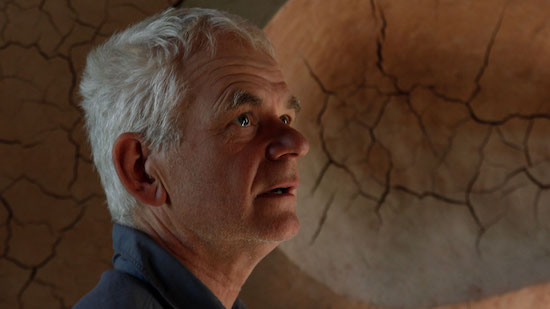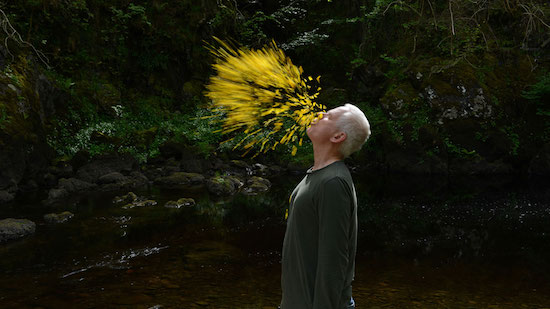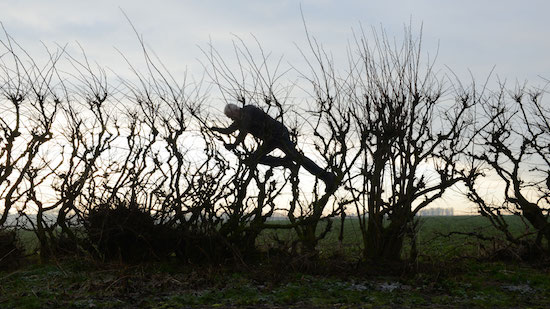Sometimes when walking in nature something uncanny may reveal itself. A group of trees might momentarily form a straight line from a particular angle as you walk past, a shaft of light may find passage through a valley cut to hit a single pool of water, stones may emerge from the ground that appear to be some planned passage or pavement.
We are creatures of pattern, and we look for such suggestions of structure and order in the apparent chaos and clutter of the natural world around us. But sometimes, just sometimes, that hint of order is actually man-made, because where you’re walking may have previously been visited by British land artist Andy Goldsworthy, subject of a new documentary by Thomas Riedelsheimer.
Goldsworthy has littered landscapes with gentle interventions and tweaks of form. Since the 1970s he has wandered the fells and hills, streams and woods of Britain leaving his trace. Sometimes that trace is ephemeral and subtle, releasing dried grass into the wind to let it scatter or creating delicate ice towers which will melt as the season’s turn. Other times there is more solidity and permanence, his works with huge boulders or long sinuous stone walls will remain in their place for decades and centuries to come.
But the uncanny and subtle is always present whatever the scale, the sense that you could just as easily not see his works in the landscape as you walk by just as much as they will visually leap out at you as a break in the natural surface, arresting you in progress, forcing you to ask where natural ends and man-made begins in a landscape which has been shaped, pushed and managed by us for the last 1000 years. This is where Goldsworthy’s work sits, at that nervous relationship between man and nature, between built place and landscape.
Rheidelsheimer has worked with Goldsworthy previously on a documentary project. Rivers and Tides from 2001 was the first collaboration between the two and this updates the story of Goldsworthy’s practice, following him across the world in the construction of new forms and projects. Time has always been a rich component of Goldsworthy’s work, so it is fitting that this film emerged from a meeting between the two in 2011, of which the director said it felt like “no time had passed” since their last meeting a decade before. The moments he creates, which are gone in seconds or last for centuries, are all about fixing man’s trace for a period.
Now, time is entering the process of making. In the first film, Goldsworthy is frequently filmed with his young children. In Leaning Into the Wind, his daughter, Holly, is now an adult practicing artist herself and clearly a key part of her father’s working process as it’s passed down the family tree.

Goldsworthy speaks of one of his projects as, “containers not for my memory, but the memory of time that continues after I have made the work… through time”, and the same can perhaps be said of how he works with Holly, over both films, as she absorbs his experiences, processes and practice for a future time beyond his.
This film comes at a fertile time for films exploring our relationship to landscape and place. Debra Granik’s recent Leave No Trace, the remarkable study of the desire to live off-grid in the USA, and the resultant overwhelming dual pressures of nature’s forces and society’s structures. In another, Paul Wright’s Arcadia uses archive footage of Britons’ nuanced relationship to land on a poetic rendering following the seasons, making for an unsettling, alluring and arresting glimpse into our rurality, normally treated with such nostalgic romanticism and pastoral pleasantness.
Lastly, Matthew Gandy’s recent documentary Natura Urbana considered abandoned plots in post-war Berlin which have offered sanctuary for urban wilderness and unique political, social and communal forms of collectivising which appear to emerge from a connectedness to plants and nature outside of the neoliberal pressures of the developing city. In a summer which has presented the heat and weather effects of the Anthropocene period like no other, these films all consider our tense relationship with nature and how we interact with it for good and bad.
Cities, those cumbersome, overloaded beasts we have developed and dropped over nature, also feature in all four films – notably in Leave No Trace, with the sharp disjunct between the cinematography of the natural parks and the urban environments the two protagonists suddenly get jerked back into. Goldsworthy says his work in the city is also working with nature, implying that our reshaping of natural materials into the rigid forms and purposes of urban existence is simply a hyper-extension of natural processes, that we, a part of nature, did this and therefore we should not separate it from a natural process. Yet, he also says he wants to “go beneath the city to find the nature” that lays underneath. It’s a phrase that brings to mind the 1968 Parisian barricade graffiti, “beneath the pavement – the beach”, with its double meaning of sand found under cobble stones uprooted to hurl at authorities, as well as the Situationist suggestion of eking out a new reading of city-ness through play and experiment to counter the order, control and capitalism of modernism.
Despite the seriousness with which he approaches his tasks, Goldsworthy’s work is full of this Situationist play in the hunt for a new way of reading place. In Edinburgh, pedestrians don’t blink when an overgrown hedge quivers oddly in an otherwise mundane and predictable street. The ripples of leaves end abruptly when Goldsworthy clambers from the long shrubbery, brushes himself down and crosses the road on foot. This is a practice he calls “hedge walking”, in which he swims along a hedge, contorting and propelling his punctured frame horizontally through nature. “You can walk on the path, or you can walk through the hedge, and there’s two different ways of looking at the world, totally different” he explains.
The father and daughter in Leave No Trace similarly choose a different path, walking along the freeway before slinking sideways into a gap in the woods and becoming subsumed into a new way of living, bivouacking in the national park, collecting rainwater and sleeping in the wild. Finding sanctuary in the landscape, to re-use a phrase Goldsworthy uses in his film.

Natura Urbana also looks for the escape that nature offers from the conformity and pressures of urban life. Berlin’s urban fallow lands which through shifting political tensions, aesthetic shifts, and financial development offered an urban respite which not only encouraged the growth of rare plants but also a space of play, creativity, political experiment and a community voice for Berliners.
These spaces are under pressure from market-forces and capital opportunities, and the question of what is lost when one loses this connection to nature and packages it up into managed experience is also a focus of Leave No Trace and Goldsworthy’s art in general. At what point does mankind have to stop what they are doing and decide that our intervention is enough, that actually these last spots should be left as they are, shouldn’t be managed and constricted by our hand?
It’s a question that Andy Goldsworthy intellectually wrestles with two thirds of the way through Leaning Into The Wind. Having woken up Riedelsheimer early one morning to scale a windswept peak carrying only a huge chainsaw, his intention was to cut into the bedrock of the plateau. The film patiently watches as he stands in silence, deep in thought. Interrupting this void he says, “what I was thinking of doing was cutting into the bedrock, it’s a big deal for me, I never have to cut into the bedrock”. His work normally re-locates or reshapes material that is dead, dislocated or found on the topsoil.
The anxiety in this question of whether to directly scar rock in its natural, rooted position is profound. It’s clear that the idea of it upsets him as deeply as most would be recoiling at the idea of causing pain to an animal. “To be honest, I don’t know if I can do it. I don’t know, I just feel this… it doesn’t feel right to do it. It’s against the place.” This is Goldsworthy at his most vulnerable and nervous, when he discovers that moment of man’s physical effect on nature, reaches his red-line and considers crossing it.
Humankind reached that collective red-line many years ago, and kept progressing forwards regardless. Leaning Into the Wind, as well as the three other aforementioned films which each concern how we relate to nature in this late capitalist age, is a timely press of the pause button of our colonial relationship to it, and asks us to question how we may want to recalibrate that relationship to the landscapes we inhabit as we move forwards.
A spoken extract from Arcadia sums this up, “In the present, of course, man is the overlord. He’s over-confident, he’s over-industrious, and he’s over-fed… We need a new humility and a reverence for the environment.”
Leaning Into The Wind is on screen and on demand from 10 August. Leave No Trace is out on DVD and Blu-Ray in October


